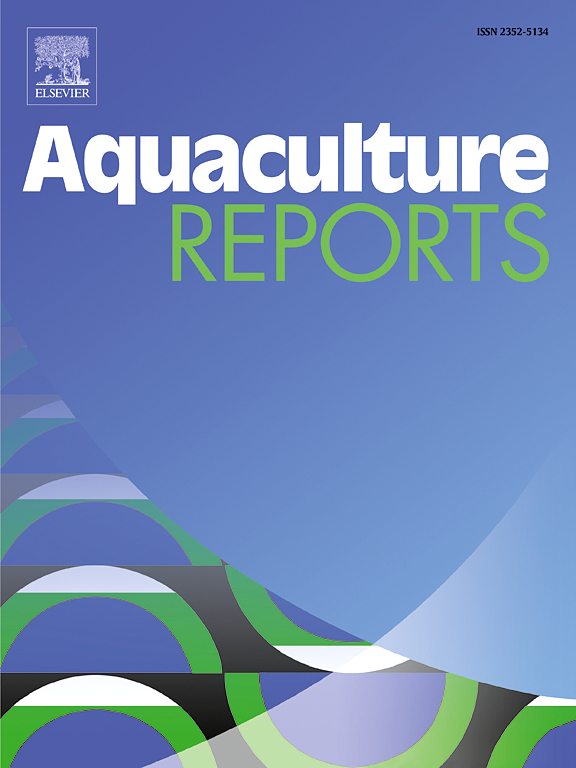Effects of different feeding patterns on growth, enzyme activity, and intestinal microbiome of the juvenile Pacific abalone Haliotis discus hannai
IF 3.2
2区 农林科学
Q1 FISHERIES
引用次数: 0
Abstract
In northern China, the predominant food sources for abalone farming include fresh kelp, salted kelp, and formulated diets, and abalone can also endure prolonged starvation when food is scarce. While there is a dearth of comprehensive investigation into the effects of these feeding patterns on the temporal dynamics of enzyme activity, and intestinal microbiome of abalone. In this study, a total of 3600 juvenile Pacific abalones were allocated to 12 tanks, randomly divided into four groups based on the feeding patterns: fresh kelp (labeled as FK), salted kelp (SK), formulated feed (FF), and starved group (S). After a 60-day feeding trial, the results showed that abalone in the FK, SK, and FF groups exhibited significant positive effects on both weight and shell growth compared to the S group (P<0.05). Notably, the FF group displayed the highest values of the growth performance. The activity of digestive enzymes and antioxidant enzymes in the FF group had an up-regulated trend over the course of feeding trial, whereas amylase and lipase activity in abalone declined along with starvation. Moreover, the microbial Shannon index showed an overall decreasing trend over time in the FF, FK, and SK groups except for the S group. The ANOSIM analysis revealed that both feeding pattern and cultivating time significantly influenced the structure of the microbial communities. Across the feeding trial, Proteobacteria, Fusobacteriota, and Firmicutes were identified as the dominant phyla in the intestinal microbiome of abalone under different feeding patterns. The core genera were Psychrilyobacter, Mycoplasma, and Vibrio. Additionally, the neutral model analysis revealed that stochastic processes both play a key role in shaping the assembly of microbial communities in different feeding patterns. This study could offer valuable insights into the impact of different feeding patterns on growth and physiology of abalone, thereby contributing to the enhancement of management strategies in the northern Chinese abalone aquaculture industry.
不同喂食模式对太平洋鲍鱼幼鱼(Haliotis discus hannai)的生长、酶活性和肠道微生物组的影响
在中国北方,鲍鱼养殖的主要食物来源包括新鲜海带、盐渍海带和配方饲料。这些饲养模式对鲍鱼酶活性和肠道微生物组的时间动态影响的综合研究还很缺乏。在这项研究中,总共 3600 只太平洋鲍鱼幼体被分配到 12 个水箱中,根据投喂模式随机分为四组:新鲜海带组(标记为 FK)、盐渍海带组(SK)、配方饲料组(FF)和饥饿组(S)。经过 60 天的喂养试验,结果表明,与 S 组相比,FK、SK 和 FF 组的鲍鱼在体重和贝壳生长方面均表现出显著的积极影响(P<0.05)。值得注意的是,FF 组的生长性能值最高。在饲养试验过程中,FF 组消化酶和抗氧化酶的活性呈上升趋势,而鲍鱼的淀粉酶和脂肪酶活性则随着饥饿而下降。此外,除 S 组外,FF、FK 和 SK 组的微生物香农指数总体呈下降趋势。ANOSIM 分析表明,投喂模式和养殖时间对微生物群落结构有显著影响。在不同的饲养模式下,鲍鱼肠道微生物群落的优势菌门分别为蛋白菌门、镰刀菌门和固着菌门。核心菌属是精神杆菌、支原体和弧菌。此外,中性模型分析表明,随机过程在不同摄食模式下微生物群落的形成中都发挥了关键作用。该研究可为了解不同投喂模式对鲍鱼生长和生理的影响提供有价值的见解,从而有助于改进中国北方鲍鱼养殖业的管理策略。
本文章由计算机程序翻译,如有差异,请以英文原文为准。
求助全文
约1分钟内获得全文
求助全文
来源期刊

Aquaculture Reports
Agricultural and Biological Sciences-Animal Science and Zoology
CiteScore
5.90
自引率
8.10%
发文量
469
审稿时长
77 days
期刊介绍:
Aquaculture Reports will publish original research papers and reviews documenting outstanding science with a regional context and focus, answering the need for high quality information on novel species, systems and regions in emerging areas of aquaculture research and development, such as integrated multi-trophic aquaculture, urban aquaculture, ornamental, unfed aquaculture, offshore aquaculture and others. Papers having industry research as priority and encompassing product development research or current industry practice are encouraged.
 求助内容:
求助内容: 应助结果提醒方式:
应助结果提醒方式:


